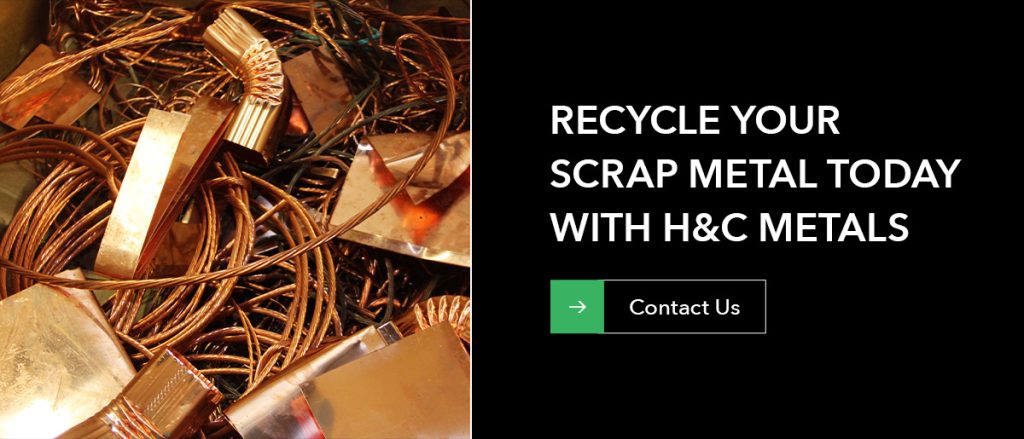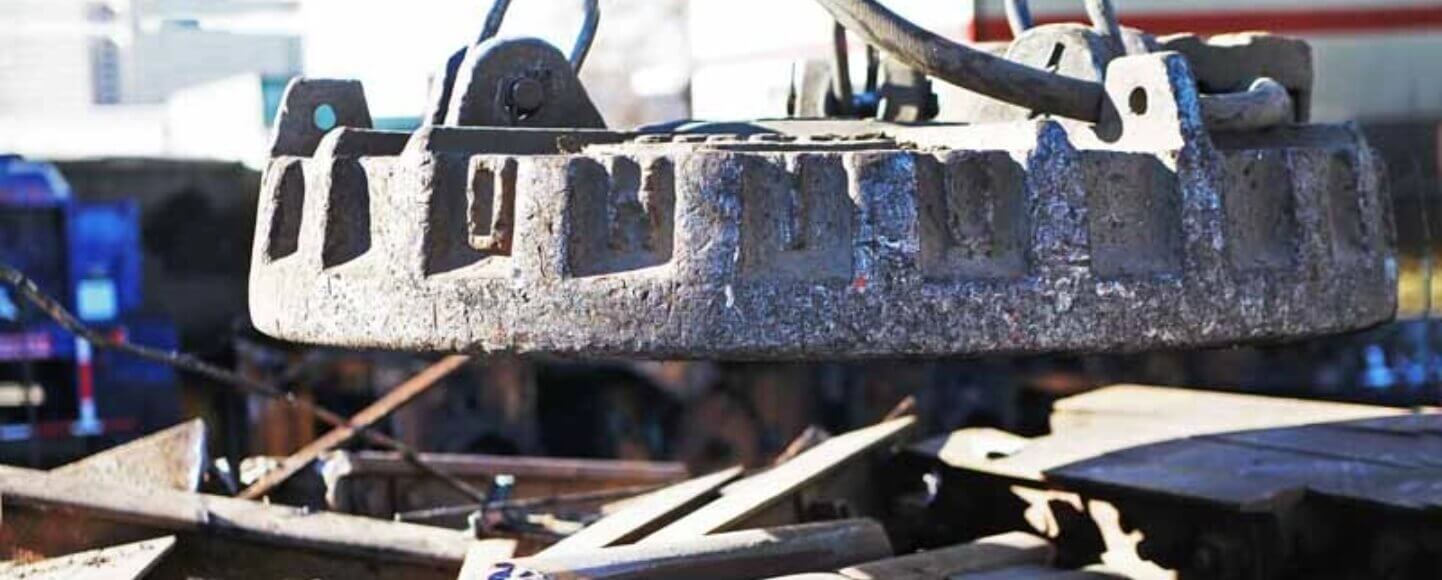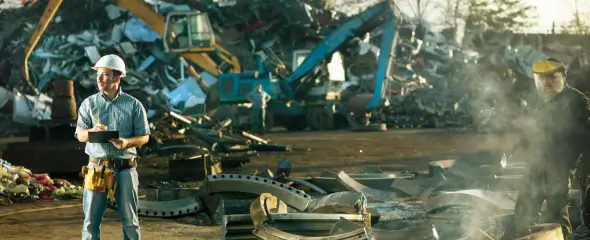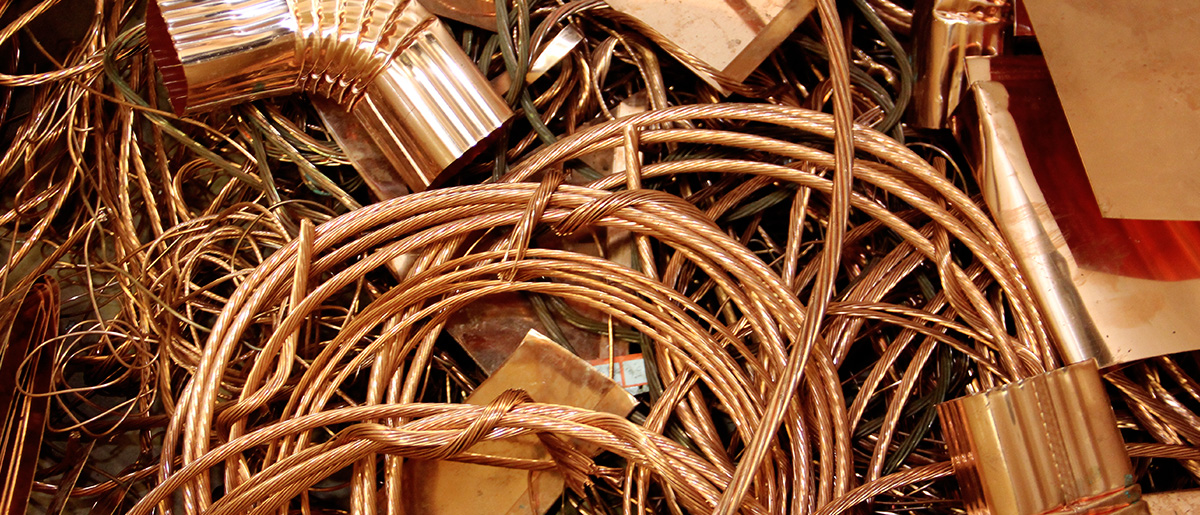
Copper is a soft metal with a reddish color, offering an array of impressive uses with an infinitely recyclable life. It has innumerable applications and uses, such as in electric motors, construction, industrial and everyday household products. If you collect copper scrap due to your profession, for example, a contractor or a construction or demolition company, or if you do your own repairs, it is helpful to know the standard scrap copper grades the nonferrous metal recycling industry recognizes.
The “grade” of copper refers to its value as a recyclable metal. Value relies on two primary factors — the purity of copper scrap and the quantity of that copper recovered when it is eventually melted.
The metal recycling industry established these grades decades ago, and scrap dealers who buy copper in the United States, including H&C Metals, universally apply this information. The consumers these dealers sell to largely influence the copper grading. The “consumers” are a key component in the next stage of the recycling of copper because they receive the copper for smelting (melting), refining and repurposing. Below, you can learn more about the most common copper grades and how to identify them.
Types of Copper Scrap and Their Grades
Scrap condition, copper content and size ultimately drive copper grade. The different types of copper wire scrap include:
Bare Bright Copper: Characteristics and Uses
Electricians and utility companies typically supply this type of copper. Also known as bright and shiny copper, bare bright is 99.9% copper and is a highly targeted item for scrap dealers and their customers due to its high value. Additionally, it should not be thinner than 16-gauge in thickness. It should be free of tarnish, oxidation, insulation, rubber or cloth residual, burnt wire, tinned, coated, plated, copper-clad (steel with copper exterior plating) and any other non-copper attachments.
It’s useful to note that this type of copper is used to make power cables that deliver high-voltage electricity into a building. Bare bright is often insulated, so dealers can strip the wire to increase value. However, stripping is not necessary for recycling.
What’s the Difference Between #1 and #2 Copper?
#1 copper is bare copper in the form of a tube, pipe, bus bar or some grades of wire that are not less than 1/16 of an inch in thickness. For example, the bus bar is used in transformers within large industrial buildings for transferring large amounts of electricity. #1 copper should not have other metals attached to it, and it should be unplated, uncoated and free of any contaminants. H&C Metals most commonly receives this copper in the form of a clean plumbing tube or pipe.
#2 copper has a minimum of 94% copper content and may come in the form of bare bright with contamination. It may also be tin-plated. Common examples of #2 copper include piping, tubing, bus bar and some grades of thin-gauge wire. It should be free of attachments such as brass, steel, die-cast, stainless steel, aluminum, lead or other solid nonmetals such as insulation, foam, excessive oil and heavy sediment.
Scrap dealers receive #2 copper as plumbing scrap with solder, paint and a small percentage of grease or dirt, as well as enameled wire, oxidized copper, electric motor windings, copper-bearing and tin-plated solids. #2 copper is often supplied by plumbers, DIYers, demolition contractors, electricians, and mechanical and HVAC contractors.
Light Copper: Applications and Value
This type of copper is sometimes referred to as “#3 copper” and comes in the form of a thin gauge sheet. Light copper should have a minimum of 92% copper content. A common example of a product in light copper form is flashing, used on the base of a chimney to prevent water from seeping between the chimney and roofline.
Other forms include gutters, old fire extinguishers, kettles, downspouts, sheet copper and boilers. Light copper should not contain brasses and bronzes, oil, soldered scrap or iron. It should also be reasonably free of tar.
Tools and Techniques for Identifying Grades of Copper Scrap
There are several ways to verify pure copper. You can leverage simple visual tests or implement advanced techniques to understand your material composition. Common techniques for identifying copper grades are:
- Visual inspection: A visual inspection is a simple, initial verification step. Pure copper is often recognizable by its reddish-orange hue. You should also look for consistent colors across the material’s surface and evaluate the smoothness of the surface texture. Cut surfaces and edges should exhibit consistent coloration, and copper should not have uneven wear patterns or signs of plating.
- Physical properties test: Copper possesses several physical properties that make it distinguishable. For example, pure copper has a specific gravity measuring between 8.89 and 8.94 grams per cubic centimeter (g/cm3). You can also test for conductivity, compare ratios of weight to volume and evaluate temperature coefficients of resistance.
- Specialized physical test: Specialized tests include magnetism assessments, oxidation verification, acoustic testing and surface examinations.
- Resistance test: You can conduct electrical resistance testing with calibrated multimeters to verify copper materials.
- Acid test: Trained professionals can complete acid tests for chemical verification. This type of test involves using nitric acid on the material surface. A single drop of acid is adequate for determining verification, but you must have known pure samples to compare the materials to.
Maximizing Value Through Purity and Recovery
Copper scrap value, like many other materials, can face fluctuations from several elements. For instance, global economic conditions and supply and demand dynamics will almost always impact material prices to some extent. However, copper presents a unique opportunity for maximizing value. You can consider the purity and recovery rates of copper to maximize value.
Purity
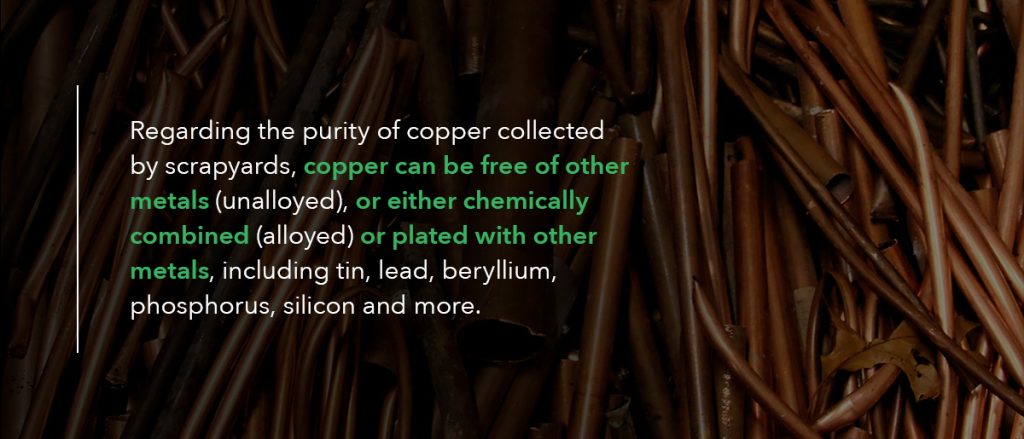
Regarding the purity of copper collected by scrapyards, copper can be free of other metals (unalloyed), or either chemically combined (alloyed) or plated with other metals, including tin, lead, beryllium, phosphorus, silicon and more. Copper can also face contamination by the presence of dirt, solder, paint, grease, oil, tape, enamel or fiber.
The value of copper scrap is affected by the cost associated with the melting process described above. The purer the copper to be melted, the lower the cost to process it. The presence of other metals or nonmetals increases the cost of the melting process. Melting, which separates metals and removes contaminants for recovery or disposal, increases operating costs and lowers scrap value.
Recovery
Recovery pertains to the amount of copper that solidifies after it’s been melted in a furnace. If 10,000 pounds of copper scrap is added to a furnace, of which 5% of the weight is solder or dirt, and 5% of the copper evaporates while melting, after the copper cools into solid material again, its recovery equates to 90%.
You can improve recovery rates by employing strategies like:
- Separating copper by grade: The first stage of preparing copper is separating materials by grade. This strategy allows you to fetch premium rates for clean copper by reducing contamination. You can use magnets to separate ferrous metals from copper scrap to avoid mixing lower-value materials. From here, separate copper by their purity levels.
- Stripping insulation: Insulation can substantially reduce copper wire value. Use wire strippers to increase the wire’s value. Avoid removing through burning methods, as this strategy may be illegal in some places and damage the copper quality. Mechanical removal should be your primary removal method.
- Keeping scrap clean: Cleaning and removing contaminants is another way to improve recovery rates. Clean copper brings higher market prices, so removing nonmetallic components like rubber insulation or plastic fittings can make a big difference. If you have surface contaminants like paint, consider using sandpaper or wire brushes to clean the material.
- Finding a reliable scrapyard: A reliable scrapyard offers fair pricing and transparency. For example, H&C Metals assists all customers with weighing and grading copper with state-certified scales. You can easily find transparent metal pricing and request quotes to ensure current and accurate prices.
Partnering With a Reliable Copper Scrap Supplier
A partnership with a reliable copper scrap supplier can benefit your business in several ways. Strong partnerships can ensure you get fair prices for metal, enhance convenience for recycling metal, and allow you to improve your bottom line by avoiding costs associated with scrap waste.
The Copper Scrap Supplier to Dealer to Consumer Relationship
Most copper-based metal products are reclaimed from scrap suppliers by scrap dealers, such as H&C Metals, as old metal and come back into production due to recycling. The industries through which a major part of these reclaimed copper products return to use are the brass and bronze ingot makers, brass and copper mills, and the secondary smelters and refiners of copper.
These industries heat and melt copper in a furnace into liquid form, from which it is poured into a cast to form an ingot — a block shape, suitable for convenient shipping to the next step in the recycling process. A manufacturer will remelt the ingot and pour the liquid copper into a mold to create a new product, such as a water pipe sold to the plumbing industry or copper wire sold to the electrical industry.
Why Work With H&C Metals?
H&C Metals is your expert commercial scrap metal recycling service provider. Whether you have a one-time material need or want a long-term partnership, we’re your one-stop shop. We provide tailored scrap metal hauling and recycling to industries like construction, demolition, industrial, consumer electronics and municipalities. We accept several material types and employ eco-friendly practices to reduce emissions.
Recycle Your Copper Scrap With H&C Metals
Whether you have any of the above grades of copper or other copper-bearing materials, such as insulated wire/cable, electric motors, transformers, armatures and stators, feel free to consult with H&C Metals for accurate valuation purposes. We rely on decades of metal recycling expertise to correctly grade and price all forms of copper scrap.
